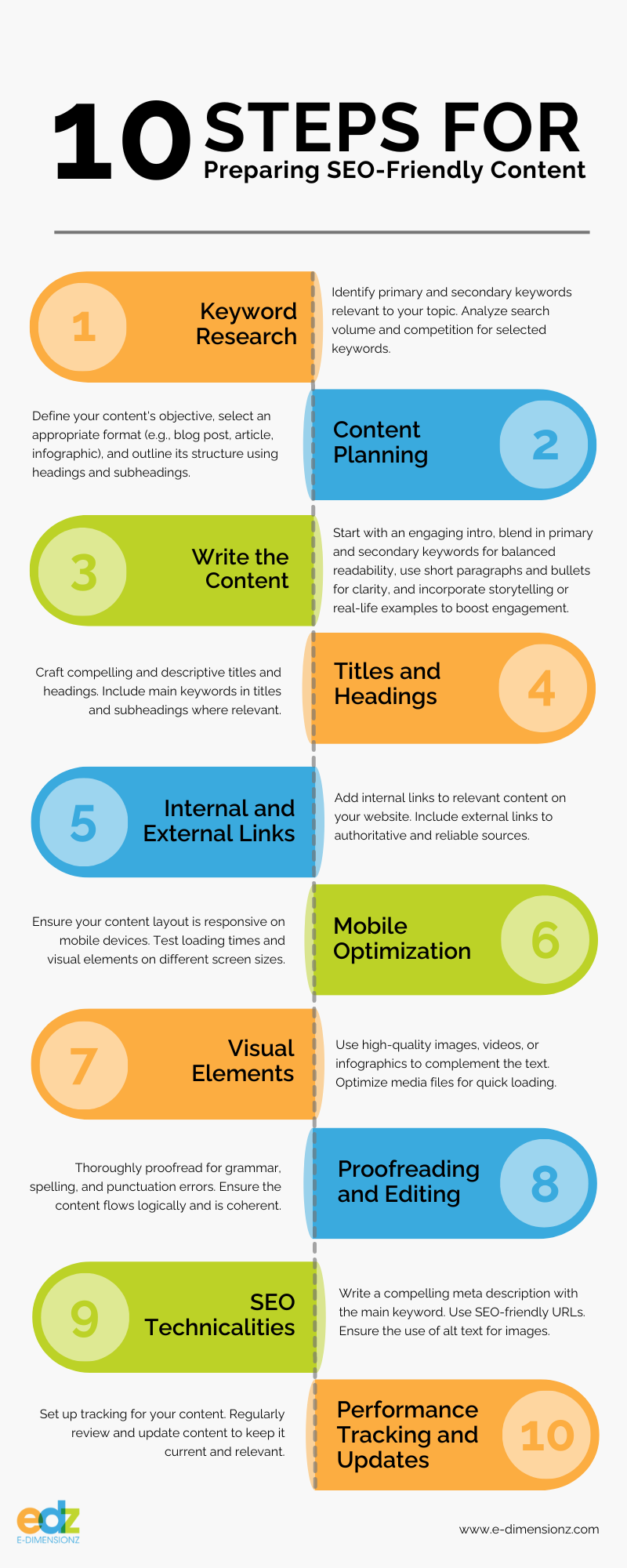SEO-friendly content is the cornerstone of enhancing online visibility and engaging effectively with your target audience. This kind of content is not just about peppering articles with keywords; it's a strategic approach to delivering information that resonates with both search engines and readers.
At the heart of this strategy is the understanding that quality content drives user engagement, which in turn signals search engines about the relevance and authority of your website.
What is SEO-Friendly Content?
SEO-friendly content is material created in a way that helps search engines rank it high in search results. But it's more than just about being friendly to search engines. This type of content is also user-friendly, providing valuable and easily accessible information to those who need it. It's a blend of quality, relevance, and optimization that speaks both to your audience and the algorithms that guide them to your content.
The importance of SEO-friendly content lies in its dual ability to engage readers and signal to search engines the relevance and authority of your website. It's about crafting content that answers questions, solves problems, or provides insights, all while incorporating specific keywords and phrases that your target audience uses to find information online.
Website Ranking and Visibility
The impact of SEO-friendly content on a website's ranking and visibility is profound. Search engines like Google use complex algorithms to rank websites, and these algorithms favour websites that offer valuable and relevant content. When your content aligns with what your audience is searching for and adheres to SEO best practices, search engines are more likely to rank it higher in search results.
A higher ranking in search results leads to greater visibility. When your content appears on the first page of search results, it's more likely to be clicked on by users. This increased traffic can lead to higher engagement rates, more conversions, and ultimately, a more successful online presence.
SEO-friendly content also contributes to the overall user experience. Websites with well-structured, informative, and relevant content tend to keep visitors engaged longer, reducing bounce rates and signaling to search engines that the website is a valuable resource. This not only helps maintain your current audience but also attracts new visitors, as search engines are more likely to suggest your content to users looking for information in your niche.
Keywords in SEO-Friendly Content
Keywords are the linchpin in the mechanism of SEO-friendly content. They are the terms and phrases that your target audience types into search engines when looking for information, products, or services. Identifying the right keywords is a critical step in creating content that not only ranks well but also aligns with the search intent of your audience.
The process begins with thorough keyword research, which involves understanding the language your potential customers use. Tools like Google Keyword Planner, Ahrefs, or SEMrush can help in this process, providing insights into the search volume, competitiveness, and variations of keywords related to your industry or topic. The goal is to identify keywords that are relevant to your content, have a decent search volume, but are not overly saturated with competition.
Once you have a list of targeted keywords, the next step is strategically incorporating them into your content. This includes placing them in key positions like titles, headings, the opening paragraph, and throughout the body of the article. However, it's important to use them contextually and naturally. The keywords should fit seamlessly into your content, maintaining the flow and readability.
Balancing Keyword Density and Readability
Keyword density refers to how many times a keyword appears in your content, relative to the total number of words. While there is no exact "ideal" density, overusing keywords can lead to what is known as 'keyword stuffing' - a practice that search engines penalize as it deteriorates the quality of the content and user experience.
The balance between keyword density and readability is important. Your content should be written primarily for your audience, not for search engines. This means that while keywords are important, they should never compromise the natural flow, clarity, or quality of your writing. Your content should be engaging, informative, and easily readable, with keywords sprinkled in a way that feels natural and adds value to the topic.
A good rule of thumb is to include keywords where they make the most sense, read naturally, and align with the user's search intent. This approach not only pleases search engines but also ensures that your content is valuable and enjoyable for your readers.
Optimizing Titles and Headings
The titles and headings within your content are not just mere organizational tools; they guide your readers through the content and signal to search engines the hierarchy and relevance of your information. Optimizing your H2 and H3 titles – the subheadings – is necessary for both readability and search engine rankings.
When crafting these titles, incorporate your targeted keywords in a way that feels natural and relevant. H2 and H3 titles break your content into digestible sections, making it easier for readers to scan and find the information they need. By embedding keywords into these titles, you not only make your content more searchable but also more user-friendly.
However, the use of keywords in titles should not detract from their primary function – to captivate and inform. Your titles should be intriguing enough to draw the reader’s attention and accurately reflect the content that follows. This encourages readers to spend more time on your page, positively influencing your SEO.
Web Content Structure
The structure of your web content goes beyond making it look organized. A well-structured article, with clear and concise titles and headings, enhances the user experience and aids in search engine optimization. Search engines like Google use these headings to understand the main and subsidiary topics in your content, which helps in accurately indexing and ranking your page.
Effective structuring involves not just the proper use of H2 and H3 tags but also ensuring that the content under each heading is relevant and on-topic. Each subheading should introduce a new but related subtopic, guiding the reader smoothly through the article. This logical flow keeps the reader engaged and helps reduce bounce rates, a factor that search engines consider when ranking pages.
Moreover, a well-structured article with optimized headings makes your content accessible to a wider audience, including those using screen readers and other assistive technologies. This inclusivity not only broadens your reach but also aligns with web accessibility standards, further enhancing the reputation of your website.
Engaging and Informative Content
Creating SEO-Friendly content that captivates and retains reader interest is a skill that balances art and strategy. The key is to produce material that is not only informative but also engaging and relatable to your audience. Here are some techniques to achieve this:
-
Know Your Audience: Understanding your audience's interests, pain points, and questions is important. Tailor your content to address these areas, making it relevant and compelling to your readers.
-
Use a Conversational Tone: Write as if you are having a conversation with your reader. This approach makes your content more relatable and easier to digest.
-
Incorporate Storytelling: People are naturally drawn to stories. Use anecdotes, case studies, or examples to illustrate your points and make your content more engaging.
-
Use Visuals and Subheadings: Break up text with relevant images, infographics, and subheadings. This not only makes your content more visually appealing but also easier to navigate.
-
Provide Actionable Insights: Offer practical advice or steps that readers can apply. This adds value to your content, making it more useful and memorable.
-
Keep It Fresh and Updated: Regularly update your content to keep it current and relevant. This practice also helps in maintaining and improving your SEO rankings.
Balancing Informative and Promotional Tone
While the primary goal of your content should be to inform and engage your audience, it’s also an opportunity to subtly promote your products or services. Striking a balance between being informative and promotional to avoid turning off your readers.
-
Provide Value First: Always prioritize delivering value through your content. Address the needs and interests of your audience before introducing your products or services.
-
Integrate Soft Promotions: When you do mention your offerings, do it subtly. Weave in mentions of your services or products in a way that feels natural and relevant to the content.
-
Focus on Solutions, Not Sales: Position your products or services as solutions to the problems or needs discussed in the content. This approach is less intrusive and more likely to resonate with your audience.
-
Include Customer Testimonials or Case Studies: Sharing success stories or testimonials can be a powerful way to promote your services without being overtly salesy.
-
Use Calls to Action Wisely: End your content with a call to action (CTA) that guides readers on the next steps, whether it’s to learn more, contact you, or view a product. Ensure that the CTA is related to the content and adds value to the reader's experience.
Quality Over Quantity
With SEO and digital marketing, the emphasis on the quality of content cannot be overstated. High-quality, well-researched content is a fundamental pillar in establishing your website's authority, trustworthiness, and relevance.
-
Builds Credibility and Trust: Content that is detailed, accurate, and informative demonstrates your expertise and knowledge in your field. This builds credibility with your audience and establishes trust over time.
-
Enhances User Engagement: Quality content that provides valuable insights, answers, or solutions keeps readers engaged. Higher engagement can lead to increased sharing, repeat visits, and ultimately, stronger customer relationships.
-
Improves SEO Rankings: Search engines favour content that offers value to users. Comprehensive and well-researched content is more likely to rank higher, as it's seen as a valuable resource for users.
-
Encourages Backlinks: High-quality content is more likely to earn backlinks from other reputable websites. Backlinks are a factor in SEO, as they signal to search engines that others vouch for your content.
Avoiding Keyword Stuffing and Maintaining Natural Flow
While keywords are an integral part of SEO, their overuse, known as keyword stuffing, can be detrimental. Here's how to avoid it and maintain a natural flow in your content:
-
Write for Humans, Not Just Search Engines: Always prioritize your reader's experience. SEO-Friendly content should be easy to read, engaging, and informative, with keywords integrated seamlessly.
-
Use Keywords Contextually: Place keywords where they make sense contextually. Force-feeding keywords breaks the natural flow and can make content sound robotic or salesy.
-
Focus on Topic Clusters: Instead of focusing solely on keywords, build your content around topic clusters. This approach allows you to cover a subject comprehensively, using related keywords naturally throughout the piece.
-
Monitor Keyword Density: While there's no strict rule for an ideal keyword density, keeping it around 1-2% is generally recommended. Use tools to check the density and ensure it doesn't overwhelm the content.
-
Use Synonyms and Related Terms: To avoid repetition, use synonyms and related terms. This not only prevents keyword stuffing but also makes your content more engaging and readable.
Internal and External Links
Integrating both internal and external links within your content is a powerful strategy to enhance its value and effectiveness. Here's how these links contribute to your content's quality and SEO performance:
Internal Links
These are links that connect one page of your website to another. They help in:
- Navigating Your Site: Internal links guide visitors through your website, improving user experience and engagement.
- Spreading Link Equity: They distribute page authority across your website, which can boost the SEO value of individual pages.
- Reducing Bounce Rate: By providing relevant additional content, internal links encourage visitors to explore your site further, reducing the likelihood of them leaving quickly.
When adding internal links, ensure they are relevant and add value to the reader's journey. This means linking to content that is contextually related and enhances the understanding or depth of the current topic.
External Links
These links connect your content to other reputable websites.
- Citing Sources: External links to authoritative sites can increase the credibility of your content.
- Providing Additional Information: They offer readers further reading options to explore a topic more deeply.
- Enhancing SEO: Linking to credible sites can positively impact your SEO, as it shows search engines that your content is well-researched and informative.
When linking externally, choose sources that are reliable and high-quality. This not only bolsters the trustworthiness of your content but also ensures that you're providing your readers with the best possible information.
Building a Network Within and Outside Your Site
Creating a network of links, both within your own site and to external sources, is akin to building a web of connections. It's about creating a seamless and enriching experience for your users and establishing your site as a hub of valuable information.
-
Strategic Internal Linking: Plan your internal linking structure to create a logical and intuitive pathway through your website. This involves linking to content that has a natural and contextual relationship.
-
Quality Over Quantity: For external links, focus on the quality of the sources rather than the number of links. It's better to have fewer links to high-quality, authoritative sites than many links to lesser-known or unreliable sources.
-
Regularly Update Links: Keep an eye on your internal and external links to ensure they remain valid and relevant. Broken links can harm your SEO and user experience.
-
Use Descriptive Anchor Texts: The clickable text in a hyperlink (anchor text) should be descriptive and indicate what the linked content is about. This helps both search engines and users understand the context of the link.
By effectively leveraging internal and external links, you not only enhance the SEO and usability of your content but also establish your site as a connected, resourceful, and authoritative destination in your field.
Mobile Optimization and Content Layout
The importance of mobile optimization for SEO is paramount. Responsive design is a factor in this optimization, as it ensures that your website is accessible and user-friendly across all devices, especially mobile phones.
-
Google's Mobile-First Indexing: Google predominantly uses the mobile version of the content for indexing and ranking. A responsive design guarantees that your site's mobile version is up to par.
-
Enhanced User Experience: Responsive websites provide a seamless experience across different screen sizes, improving user satisfaction and engagement, which are positive signals for search engines.
-
Lower Bounce Rates: A mobile-optimized site keeps users engaged longer, reducing bounce rates. High bounce rates can negatively impact your SEO, as they suggest the content might not be relevant.
-
Faster Load Times: Responsive design often leads to faster loading times on mobile devices, a factor in SEO. Google favours sites that load quickly, as it enhances the user experience.
Tips for Formatting Content for Mobile Users
Creating content that is easily digestible on mobile devices requires particular attention to layout and design. Here are some tips to optimize your content for mobile users:
-
Use Short Paragraphs: Long blocks of text can be daunting on a small screen. Break your content into shorter paragraphs to enhance readability.
-
Incorporate Bullet Points or Lists: These help in breaking down information into manageable, easy-to-scan chunks, which is particularly effective for mobile users.
-
Optimize Images and Media: Ensure that images and other media are optimized for fast loading and are responsive, so they adjust to different screen sizes without losing quality.
-
Use Large, Readable Fonts: Small fonts can be challenging to read on mobile devices. Choose font sizes and styles that are easy to read on smaller screens.
-
Accessible Navigation: Make sure that your site’s navigation is easy to use on a mobile device. Menus should be collapsible and links easy to click.
-
Touch-Friendly Buttons and CTAs: Ensure that buttons and call-to-action (CTA) elements are sized appropriately for touch screens. Users should be able to tap them easily without zooming in.
-
Test Your Design: Regularly test your website on various devices to ensure that it remains responsive and user-friendly. Tools like Google's mobile-friendly test can be helpful in this regard.
By prioritizing mobile optimization and responsive content layout, you not only cater to the vast majority of internet users but also align your site with SEO best practices, ensuring better visibility and reach in search engine results.
Regular Updates and Content Freshness
The freshness of your content maintains its relevance and effectiveness. Regular updates to your content ensure that it remains accurate, engaging, and SEO-friendly.
-
Maintaining Accuracy: Over time, information becomes outdated. Regular updates keep your content accurate and reliable, which is vital for retaining user trust and credibility.
-
Boosting SEO: Search engines favour current and updated content. Frequently refreshed content is more likely to rank higher in search results, as it signals to search engines that your website is active and relevant.
-
Re-engaging Audience: Updating content provides an opportunity to re-engage with your audience. It can bring back previous visitors and attract new ones, offering them the latest information.
-
Adapting to Market Changes: Regular updates allow you to adjust your content to reflect current market trends, changes in user behaviour, and evolving industry standards.
Frequency and Relevance of Updates
The frequency and relevance of your content updates are linked to their effectiveness.
-
Audit Your Content Regularly: Conduct periodic audits of your website content to identify pieces that need updates. This includes checking for outdated statistics, broken links, or changes in industry practices.
-
Schedule Regular Updates: Depending on the nature of your content, set a schedule for regular updates. Some content might need monthly updates, while others might require annual revisions.
-
Prioritize by Relevance: Not all content requires frequent updates. Prioritize based on the content’s importance, popularity, and the speed at which its subject matter changes.
-
Update for Substance: When updating content, focus on substantial changes that add value. This could include adding new sections, updating statistics, refining SEO strategies, or enhancing readability.
-
Communicate Updates: Let your audience know about content updates. This can be done through update notices on the content page, social media posts, or email newsletters.
-
Leverage Analytics: Use website analytics to identify which content performs well and could benefit from updates. Pay attention to user engagement metrics to guide your update strategy.
Regular updates and maintaining the freshness of your content is a commitment to quality and relevance. By doing so, you not only keep your website current but also reinforce its position in search engine rankings and in the minds of your audience.
Measuring Content Performance
Evaluating the performance of your content to understand its impact and to refine your SEO-Friendly content strategies. Various tools and metrics can provide valuable insights into how your content is performing.
-
Google Analytics: This is a comprehensive tool for tracking website traffic, user behaviour, and engagement. Metrics include page views, bounce rate, average session duration, and new vs. returning visitors.
-
SEO Tools like SEMrush or Ahrefs: These tools offer insights into keyword rankings, backlink profiles, and competitor analysis. They help in understanding how well your content is performing in search engine rankings.
-
Social Media Analytics: Platforms like Facebook, Twitter, and LinkedIn provide analytics to track how your content is performing on social media. Metrics such as likes, shares, comments, and reach are important indicators of engagement.
-
Conversion Rate Tracking Tools: Tools like Google Tag Manager or Hotjar can help track conversions and user interactions on your website. This is important for understanding how effectively your content is leading to desired actions.
Analytics to Refine Strategies
Merely collecting data isn't enough; understanding and interpreting analytics to refine your SEO-Friendly content strategy.
-
Identify High-Performing Content: Look at which pieces of content are performing best in terms of traffic, engagement, and conversions. Analyze what makes them successful and replicate these elements in future content.
-
Understand User Behaviour: Analyze how users interact with your content. High bounce rates or short session durations might indicate that your content is not meeting user expectations or is not sufficiently engaging.
-
Track Keyword Rankings: Monitor how your content ranks for target keywords. If certain keywords are underperforming, consider revising the content or adjusting your SEO strategy.
-
Evaluate Backlinks: Assess the quality and quantity of backlinks to your content. A growing number of high-quality backlinks indicates that your content is considered valuable and authoritative.
-
Adjust Based on Trends: Look for trends in user behaviour and content performance over time. This can inform decisions on content updates, design changes, or new content topics.
-
Set Performance Goals: Use analytics to set and track specific performance goals for your content. Regularly review these goals to assess progress and make adjustments as needed.
By leveraging these tools and metrics, you can gain a deep understanding of how your content is performing and how it's perceived by your audience. This knowledge is vital for continuously refining your strategies, ensuring your content not only resonates with your audience but also achieves your business objectives.
Checklist for Preparing SEO-Friendly Content
 Creating SEO-friendly content requires meticulous preparation and attention to detail. To ensure you're on the right track, here’s a checklist to guide you through the process:
Creating SEO-friendly content requires meticulous preparation and attention to detail. To ensure you're on the right track, here’s a checklist to guide you through the process:
- Keyword Research:
- Identify primary and secondary keywords relevant to your topic.
- Analyze search volume and competition for selected keywords.
- Content Planning:
- Define the objective of your content.
- Choose a suitable content format (blog post, article, infographic, etc.).
- Outline the structure of your content with headings and subheadings.
- Writing the Content:
- Start with an engaging and informative introduction.
- Naturally integrate primary and secondary keywords.
- Maintain a balance between readability and keyword density.
- Use short paragraphs and bullet points for better readability.
- Include storytelling or real-life examples to enhance engagement.
- Optimizing Titles and Headings:
- Craft compelling and descriptive titles and headings.
- Include main keywords in titles and subheadings where relevant.
- Using Internal and External Links:
- Add internal links to relevant content on your website.
- Include external links to authoritative and reliable sources.
- Mobile Optimization:
- Ensure your content layout is responsive on mobile devices.
- Test loading times and visual elements on different screen sizes.
- Including Visual Elements:
- Use high-quality images, videos, or infographics to complement the text.
- Optimize media files for quick loading.
- Proofreading and Editing:
- Thoroughly proofread for grammar, spelling, and punctuation errors.
- Ensure the content flows logically and is coherent.
- SEO Technicalities:
- Write a compelling meta description with the main keyword.
- Use SEO-friendly URLs.
- Ensure the use of alt text for images.
- Performance Tracking and Updates:
- Set up tracking for your content using tools like Google Analytics.
- Regularly review and update the content to keep it current and relevant.
Charting Your Path in SEO
By applying these principles, you can craft content that not only ranks well in search engines but also genuinely connects and provides value to your audience. It's a journey of combining art with analytics, creativity with strategy, and vision with execution.
Keep these guidelines in mind, and don't hesitate to innovate and adapt. The world of SEO-friendly content is dynamic and rewarding, offering endless opportunities for those willing to explore and excel. Good luck, and may your content not only reach the summit of search engine rankings but also the minds and hearts of your audience.




